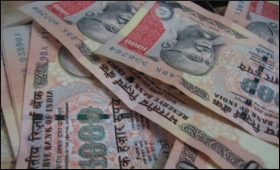
With increase of capital flows in to the country once again, C Rangarajan Chairman of the Prime Minister's Economic Advisory Council (PMEAC) feels that it will help in the strengthening of the rupee in the near future.
"...when there is a mismatch between the current account deficit and capital flows, there is a pressure on the rupee. But as I see it going ahead, the capital flows will return back to the market. Apart from Foreign Institutional Investors (FIIs) inflow, there are three other channels of capital flows. One is the foreign direct investment (FDI) and the other is external commercial borrowing (ECB) and the third is the NRIs deposits," he said in the sidelines of a PHD Chamber seminar on "Refueling India’s Growth Story: Imperatives and Impediments", in New Delhi on Monday.
He said this kind of mismatch really put a pressure on the rupee. Therefore, the immediate reactions come to the FII flows but it is expected that capital flows to pick up in the near future.
When asked whether the focus is on growth at the moment, he added, "The focus cannot be exclusively on anything. We need stability in the foreign exchange market. We need stability in the price situation and we also need growth. All of these are interrelated objectives and all of these needs to be pursued."
Rangarajan also added that there are short term issues and there are issues that need to be addressed immediately. In fact, there are issues that need to be addressed in the medium term and there are issues to be addressed that are not strictly economically concerned. This has to be addressed soon.
"Both in fiscal 2013-13 and 2013-14, we had three types of shocks one the supply side bottlenecks, price shocks, and there is a weakening in the investment demand," he added.
On the GDP growth Rangarajan further said, "If you want to address and move on to a higher growth path then all these have to be addressed. I do expect the growth rate in the current fiscal in 2013-14 to be around 5.5 to 6 percent."
To bring the Indian economy back on track, the government has implemented several measures and the impact of the reform measures will be felt soon, he said, "Over the last six months several measures have been taken by the government in order to revive investment sentiments in the country. And, full impact of these measures will be felt not in the first half of the year but in the second half of the year."
"We know that the numbers that have come in the first quarter are not very encouraging. Industrial production in the first quarter is negative. But the impact of whatever measures we have taken whether in the area of prices or in the area of encouraging the scope of foreign direct investment. All of this will take some time or their effects will be felt probably by the second half of the current fiscal."
He added that if both the savings rates and investment rates are maintained then there are chances that the Indian economy may grow at 8 to 9 per cent. There are three macro economic concerns that we need to address such as taming inflation, balance of payment and fiscal consolidation. This will lead to faster growth in the economy.
Moreover, there should some price stability in the market if there needs to foreign exchange stability, he added at length.